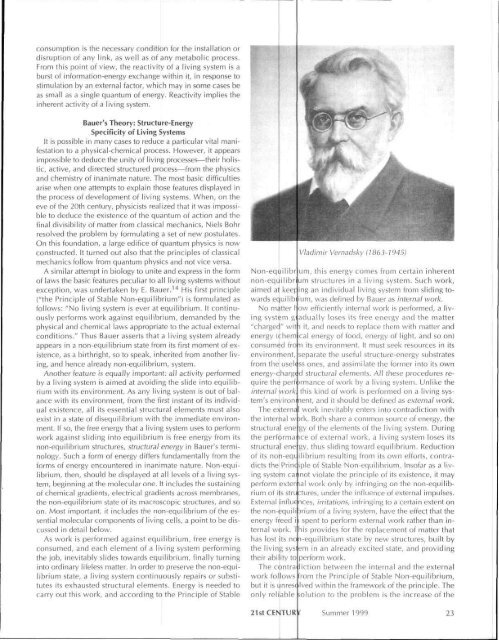Back to the Moon with Nuclear Rockets
Back to the Moon with Nuclear Rockets
Back to the Moon with Nuclear Rockets
- No tags were found...
You also want an ePaper? Increase the reach of your titles
YUMPU automatically turns print PDFs into web optimized ePapers that Google loves.
consumption is <strong>the</strong> necessary condition for <strong>the</strong> installation ordisruption of any link, as well as of any metabolic process.From this point of view, <strong>the</strong> reactivity of a living system is aburst of information-energy exchange <strong>with</strong>in it, in response <strong>to</strong>stimulation by an external fac<strong>to</strong>r, which may in some cases beas small as a single quantum of energy. Reactivity implies <strong>the</strong>inherent activity of a living system.Bauer's Theory: Structure-EnergySpecificity of Living SystemsIt is possible in many cases <strong>to</strong> reduce a particular vital manifestation<strong>to</strong> a physical-chemical process. However, it appearsimpossible <strong>to</strong> deduce <strong>the</strong> unity of living processes—<strong>the</strong>ir holistic,active, and directed structured process—from <strong>the</strong> physicsand chemistry of inanimate nature. The most basic difficultiesarise when one attempts <strong>to</strong> explain those features displayed in<strong>the</strong> process of development of living systems. When, on <strong>the</strong>eve of <strong>the</strong> 20th century, physicists realized that it was impossible<strong>to</strong> deduce <strong>the</strong> existence of <strong>the</strong> quantum of action and <strong>the</strong>final divisibility of matter from classical mechanics, Niels Bohrresolved <strong>the</strong> problem by formulating a set of new postulates.On this foundation, a large edifice of quantum physics is nowconstructed. It turned out also that <strong>the</strong> principles of classicalmechanics follow from quantum physics and not vice versa.A similar attempt in biology <strong>to</strong> unite and express in <strong>the</strong> formof laws <strong>the</strong> basic features peculiar <strong>to</strong> all living systems <strong>with</strong>outexception, was undertaken by E. Bauer. 14 His first principle("<strong>the</strong> Principle of Stable Non-equilibrium") is formulated asfollows: "No living system is ever at equilibrium. It continuouslyperforms work against equilibrium, demanded by <strong>the</strong>physical and chemical laws appropriate <strong>to</strong> <strong>the</strong> actual externalconditions." Thus Bauer asserts that a living system alreadyappears in a non-equilibrium state from its first moment of existence,as a birthright, so <strong>to</strong> speak, inherited from ano<strong>the</strong>r living,and hence already non-equilibrium, system.Ano<strong>the</strong>r feature is equally important: all activity performedby a living system is aimed at avoiding <strong>the</strong> slide in<strong>to</strong> equilibrium<strong>with</strong> its environment. As any living system is out of balance<strong>with</strong> its environment, from <strong>the</strong> first instant of its individualexistence, all its essential structural elements must alsoexist in a state of disequilibrium <strong>with</strong> <strong>the</strong> immediate environment.If so, <strong>the</strong> free energy that a living system uses <strong>to</strong> performwork against sliding in<strong>to</strong> equilibrium is free energy from itsnon-equilibrium structures, structural energy in Bauer's terminology.Such a form of energy differs fundamentally from <strong>the</strong>forms of energy encountered in inanimate nature. Non-equilibrium,<strong>the</strong>n, should be displayed at all levels of a living system,beginning at <strong>the</strong> molecular one. It includes <strong>the</strong> sustainingof chemical gradients, electrical gradients across membranes,<strong>the</strong> non-equilibrium state of its macroscopic structures, and soon. Most important, it includes <strong>the</strong> non-equilibrium of <strong>the</strong> essentialmolecular components of living cells, a point <strong>to</strong> be discussedin detail below.As work is performed against equilibrium, free energy isconsumed, and each element of a living system performing<strong>the</strong> job, inevitably slides <strong>to</strong>wards equilibrium, finally turningin<strong>to</strong> ordinary lifeless matter. In order <strong>to</strong> preserve <strong>the</strong> non-equilibriumstate, a living system continuously repairs or substitutesits exhausted structural elements. Energy is needed <strong>to</strong>carry out this work, and according <strong>to</strong> <strong>the</strong> Principle of StableVladimir Vernadsky (1863-1945)Non-equilibr urn, this energy comes from certain inherentnon-equilibrium structures in a living system. Such work,aimed at keep ing an individual living system from sliding <strong>to</strong>wardsequilibi ium, was defined by Bauer as internal work.No matter r ow efficiently internal work is performed, a livingsystem g adually loses its free energy and <strong>the</strong> matter"charged" witi it, and needs <strong>to</strong> replace <strong>the</strong>m <strong>with</strong> matter andenergy (chem cal energy of food, energy of light, and so on)consumed fron its environment. It must seek resources in itsenvironment, separate <strong>the</strong> useful structure-energy substratesfrom <strong>the</strong> usek ss ones, and assimilate <strong>the</strong> former in<strong>to</strong> its ownenergy-chargf d structural elements. All <strong>the</strong>se procedures require<strong>the</strong> perf >rmance of work by a living system. Unlike <strong>the</strong>internal work this kind of work is performed on a living system'senvironi nent, and it should be defined as external work.The external work inevitably enters in<strong>to</strong> contradiction <strong>with</strong><strong>the</strong> internal w )rk. Both share a common source of energy, <strong>the</strong>structural ene gy of <strong>the</strong> elements of <strong>the</strong> living system. During<strong>the</strong> performa ice of external work, a living system loses itsstructural ene gy, thus sliding <strong>to</strong>ward equilibrium. Reductionof its non-eqi ilibrium resulting from its own efforts, contradicts<strong>the</strong> Princ iple of Stable Non-equilibrium. Insofar as a livingsystem cannot violate <strong>the</strong> principle of its existence, it mayperform exter lal work only by infringing on <strong>the</strong> non-equilibriumof its stru :tures, under <strong>the</strong> influence of external impulses.External influe nces, irritations, infringing <strong>to</strong> a certain extent on<strong>the</strong> non-equili 3rium of a living system, have <strong>the</strong> effect that <strong>the</strong>energy freed i; spent <strong>to</strong> perform external work ra<strong>the</strong>r than internalwork. This provides for <strong>the</strong> replacement of matter thathas lost its non-equilibrium state by new structures, built by<strong>the</strong> living sys'em in an already excited state, and providing<strong>the</strong>ir ability <strong>to</strong> perform work.The contra Jiction between <strong>the</strong> internal and <strong>the</strong> externalwork follows from <strong>the</strong> Principle of Stable Non-equilibrium,but it is unresc Ived <strong>with</strong>in <strong>the</strong> framework of <strong>the</strong> principle. Theonly reliable ;olution <strong>to</strong> <strong>the</strong> problem is <strong>the</strong> increase of <strong>the</strong>21st CENTURASummer 1999 23
















